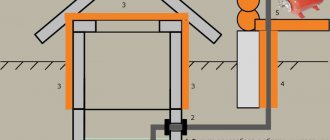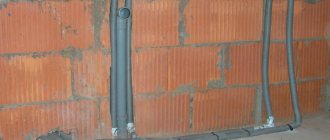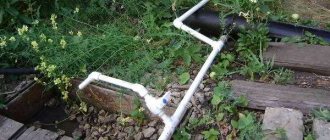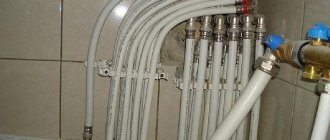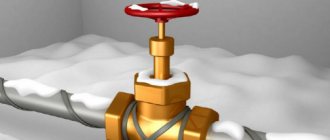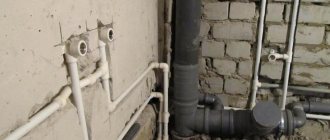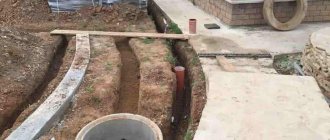Water supply network level
Everyone knows that the most dangerous phenomenon for the water supply network is freezing due to the temperature dropping to sub-zero values in winter. At the same time, the water turns into ice, expanding in volume, and breaks pipes and pipeline fittings. That is why the main rule for laying a water supply network is to deepen those sections of it that run along the street below the level to which the soil freezes.
But this is not the only indicator that is used when choosing the depth of pipes. Other factors are also important: the temperature of the pumped water, the type and diameter of the pipes, the operating mode of the system, the presence of additional insulation, etc.
Freezing depth
This level depends on the minimum winter air temperature, the depth of snow cover, soil composition, the height of groundwater and other factors specific to each area. The good news for novice developers is that they will not have to perform complex calculations or involve specialists in them, since each region has ready-made pipe laying standards that take into account all these indicators.
Map of soil freezing depths Source stroy-svoy-dom.com
Having determined the maximum level of soil freezing from a map or special tables, add 50 cm to it and determine at what depth to bury the water pipe so that the water in it is guaranteed not to freeze.
However, it is not always possible to dig a trench of the required depth. This can be hampered by the complex structure of the soil, the close presence of groundwater, or, as in the Far North, the need to use special equipment and the need to go deeper by 3 meters or more, which leads to unreasonably high costs.
In such cases, the pipes are laid above the design level, but they must be insulated using insulating materials or modern heating cables that maintain a certain temperature of the liquid.
The type and thickness of insulation depend on the depth of installation and other parameters Source avatars.mds.yandex.net
Soil composition
Even in one area, the ground can freeze to different depths if the composition of the soil in different areas is different. For example, if we take the freezing depth of soft and loose sandy soil as the standard mark, then in the case of clay soil it can be reduced by 30 cm. And with hard and rocky soil it can be increased by the same distance.
Therefore, it is better to focus not on the average standards set out in SNiP, but on the data obtained by local geodetic organizations based on research and long-term observations.
Type of pipes used
Previously, communications were built mainly from metal pipes (cast iron, steel, copper), the strength of which was not questioned. They could withstand even very high soil pressure, so this indicator was not taken into account at what depth to bury a sewer pipe or drinking water pipe.
Now they are trying to replace old steel lines with new plastic ones Source gidroguru.com
Today, these systems are assembled from more modern polymer materials, which have many advantages over traditional ones:
- low cost;
- light weight;
- immunity to liquids, including chemically aggressive ones;
- no corrosion;
- smooth surface that prevents clogging of the internal section of pipes, etc.
But the strength of such pipes is much lower: under soil pressure they can deform or collapse. Therefore, you need to look at their appearance and markings, which reflect the wall thickness or the maximum pressure they can withstand.
As a rule, HDPE (low-density polyethylene) pipes are used for underground installation of pressure water pipes. This material is plastic and has sufficient flexibility, and therefore pipes made from it can withstand high pressure and do not burst when water freezes for a short time. However, their grade must be at least PN10, and their diameter must be at least 25 mm.
Advice! If there is likely to be a high load on the ground above the place where the pipeline is laid (a highway, the foundation of a house or other building), the problem of how deep to bury the pipe can be solved not by increasing it, but by installing a durable protective case made of concrete or steel.
HDPE pipes are the best solution for installing external water supply Source images.ru.prom.st
See also: Catalog of companies that specialize in septic tanks and autonomous sewerage
When installing a seasonal summer water pipeline, from which water is drained for the winter, it is buried at least half a meter if a road passes over the main line. This is done to prevent pipes from being damaged by pressure from heavy vehicles. The same rule also applies in the southern regions, where the ground does not freeze to great depths, but the pipeline needs protection from mechanical damage, which is provided by the thickness of the soil above it.
If hot water is supplied to the house from a centralized source, reinforced or metal-plastic products are used for this line. It is advisable to insulate them regardless of the depth of installation in order to reduce heat loss along the way from the source to the room.
The main factors that influence the determination of the depth of the water pipe
- Maintaining the temperature in a given area during the cold and hot seasons. At low temperatures, the water in the pipes freezes; at high temperatures, its integrity is compromised; both temperature factors affect the functionality of the plumbing system;
- Properties and characteristics of the soil (the depth indicator varies depending on the type of soil: clayey, viscous - 1.3 m, soft, loose - 1.6 m, hard - 1.9 m);
- The presence of vegetation on the surface of the earth (shrubs with growing massive roots damage the integrity of the water supply system);
- The temperature of the water passing through the water supply (frequent temperature changes negatively affect the structure of the pipe system);
- Percentage of direct sunlight (exposure to the sun will affect the outer shell of the pipe and will shorten the duration of its use);
- Availability and distance of groundwater (if the water is too close, then only shallow trenches can be used).
To perform the job efficiently and for a long service life, take into account all the factors presented.
Video description
The video will tell you more about choosing pipes for underground water supply:
Other factors
There are also objective factors that influence the calculations. For example, the depth at which the central water supply pipe is located, to which it is planned to connect, or the bottom of the caisson above the water well.
You should not neglect such parameters as the amount of precipitation in the region and the groundwater level. When they are high, the pipes may float, which is prevented by backfilling with soil at least 100 cm thick or by anchoring the pipeline.
The conditions for using the land above the water main should also be taken into account. If there is a pedestrian path, parking lot or other object above it from which snow is cleared in winter, then the soil in this place will freeze more strongly than under the snow cover.
Step-by-step guide to laying a pipeline in the ground
- First of all, dig a place for the water pipe to pass through. Choose the width of the trench yourself. The main condition is the distance of the communication system from other engineering objects of 0.5-1 m;
- Using a welding machine, connect the pipes used for installation;
- To avoid soil displacement, it is necessary to pour sand 15 centimeters high at the bottom of the trench;
- Before installation, the pipes are thermally insulated. In order to create optimal pressure in the pipe when entering the house, you need to lay it at a slight angle, tilting it towards the house in a vertical plane;
- Provide high thermal insulation at the points of entry and exit of communications from the ground to prevent freezing of the water supply;
- On the first day after installing the structure, check its functionality. Pay attention to whether there are leaks in the pipes, whether there is sufficient pressure when supplying water;
- If the inspection reveals no violations, dig a trench. At the very beginning, pour a layer of sand 15 centimeters high, followed by soil.
Testing the performance of water supply pipes is mandatory. Before you start digging a trench, don't forget about this.
As you can see, in order to determine the depth of the water pipeline, many factors should be taken into account that will directly affect the quality and service life of the constructed communication system.
Sewer level
Slightly different rules apply when deciding how deep to bury a sewer pipe in a private house. This system works differently: wastewater is either drained into the septic tank by gravity due to the slope, or is pumped by a pump, so it does not linger in the pipes and there is nothing to freeze in them.
Scheme of an autonomous sewerage system Source www.alta-sib.ru
How to dig a trench for a water supply
To dig ditches <1 m deep, small-sized equipment is used - walk-behind tractors with mounted cutting attachments. The width of the gap for placing the pipeline ends up being 15-20 cm.
Digging a trench with an excavator with a narrow bucket.
In the layer interval of 1-2 m, a more powerful attachment to the tractor is used - a bar, which is a belt or chain mechanism with buckets reinforced with carbide teeth. Using a bar machine, a ditch with vertical walls 30 cm wide is formed in hard, frozen rocks.
Trenches for laying pipes in the soil to a depth of ≥2 m are dug using excavators with a narrow bucket : the width of the ditch is 50 cm. If the ditch is traversed manually, safety measures must be taken to prevent possible collapse of the walls.
Basic rules for constructing a ditch:
- The width of the bottom according to SNiP is ≥70 cm. In practice, the requirement is often violated: in order to reduce the volume of soil removed, the canvas is narrowed to 50 cm.
- The mass of earth extracted from the subsoil is placed at a distance of 2-3 m from the boundaries of the excavation so that the walls of the excavation do not collapse under its weight.
- The slopes of the ditch are left vertical in soils: clayey - to a depth of 1.5 m, especially dense - 2.0 m. In other cases, with such deepening, the trench walls are leveled to the natural angle of repose of the rock.
A sand and gravel cushion 15-20 cm thick is poured along the bottom of the ditch, compacted and moistened with water. Afterwards the pipes are laid and connected and a test run is done. If there are no leaks, the excavation is backfilled with previously excavated soil.
Distance between two pipes underground
Building codes prohibit the placement of water and domestic sewage pipelines in the same trench. Laying HDPE pipes in different ditches is permitted if the distance between them is ≥1.5 m.
If the intersection of two communications cannot be avoided, the water supply is located ≥20 cm above the sewer pipe.
Minimum distances of water pipelines to other communications and structures:
- 2 m - high pressure gas pipeline;
- 1.5 m - heating mains and drainage and storm sewerage;
- 1 m - low and medium pressure gas pipelines;
- 50 cm - low-voltage power cables used for communication, in accordance with the PUE.
If the cable line is insulated with a plastic pipe, it can be laid in the same trench with the water supply, but ≥25 cm above it. In this case, the voltage transmitted through the cable is <35 kV. The intersections of communications are protected by cases made of steel and concrete; their slopes must be one-sided.
Why do you need a calculation?
Water and sewer pipes must be laid in the ground to a certain depth. This parameter is regulated by SNiP, SP, and must be strictly observed .
If you incorrectly calculate the depth of the trench, during operation of the water supply system it may freeze and be damaged. The width of the trench also matters, since you need to lay a pipe in it and provide a layer of insulation.
During construction, you also need to know the area to determine the volume of excavation work.



